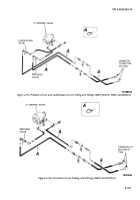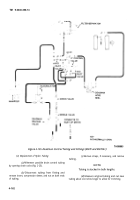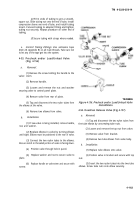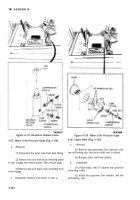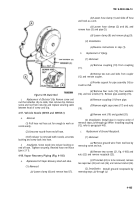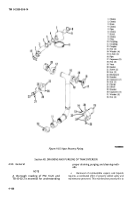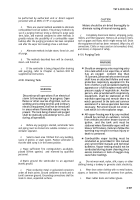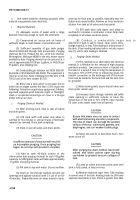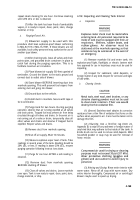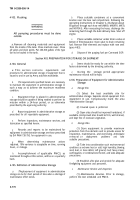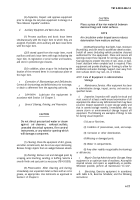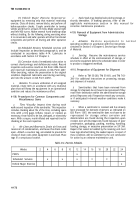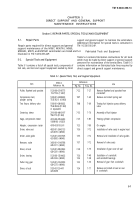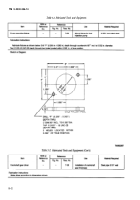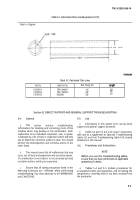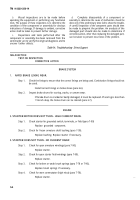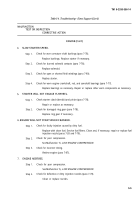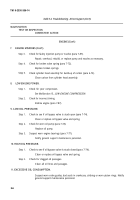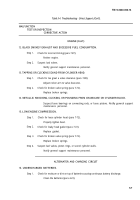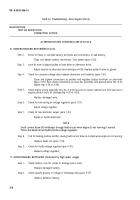TM-9-2330-356-14
SEMITRAILER, TANK: 5000 GALLON, BULK HAUL, SELF LOAD/UNLOAD M967 AND M967A1; SEMITRAILER, TANK: 5000 GALLON, FUEL DISPENSING, AUTOMOTIVE M969 AND M969A1; SEMITRAILER, TANK: 5000 GALLON, FUEL DISPENSING, UNDER/OVERWING AIRCRAFT M970 AND M970A1
TECHNICAL MANUAL; OPERATOR’S, UNIT, DIRECT SUPPORT, AND GENERAL SUPPORT MAINTENANCE MANUAL
OCTOBER 1990
TM-9-2330-356-14 - Page 307 of 528
TM 9-2330-356-14
(2)
Inspection,
Inspect and approve equipment
prior to storage. Do not place equipment in storage in a
“Non Mission Capable” condition.
d.
Auxiliary Equipment and Basic Issue Items.
(1) Process auxiliary and basic issue items
simultaneously with the major item to which they are
assigned. If possible, store auxiliary and basic issue items
with the major item.
(2)
If stored apart from the major item, mark
auxiliary and basic issue items with tags indicating the
major item, its registration or serial number and locations,
and store in protective type closures.
(3) In addition, place a tag or list indicating the
location of the removed items in a conspicuous place on
the major item.
e.
Correction of Shortcomings and Deficiencies.
Correct all shortcomings and deficiencies prior to storage,
or obtain a deferment from the approving authority.
f.
Lubrication.
Lubricate the equipment in
accordance with Section I of Chapter 3.
g.
Genera! Cleaning, Painting, and Presenation.
CAUTION
CAUTION
Place a piece of barrier material between
desiccant bags and metal surfaces.
NOTE
Air circulation under draped covers reduces
deterioration from moisture and heat.
(4)
Weatherproofing.
Sunlight, heat, moisture
(humidity), and dirt tend to accelerate deterioration.
Install all covers (including vehicle protective closures)
authorized for the equipment. Close and secure all
openings except those required for venting and draining.
Seal openings to prevent the entry of rain, snow, or dust.
Insert desiccant when complete seal is required. Place
equipment and provide blocking or framing to allow for
ventilation and water drainage. Support cover away from
item surfaces which may rust, rot, or mildew.
4-107. Care of Equipment in Administrative
Storage
a.
Maintenance Services.
After equipment has been
in administrative storage, inspect, service, and exercise as
specified herein.
b.
Inspection.
Inspection will usually be visual and
must consist of at least a walk-around examination of all
equipment to observe any deficiencies that may have
occurred. Inspect equipment in open storage weekly and
that in covered storage monthly. Immediately after any
severe storm or environmental change inspect all
equipment. The following are examples of things to look
for during visual inspection:
Do not direct pressurized water or steam
(1) Low or flat tires.
against
air cleaners,
exhaust outlets,
unsealed electrical systems, fire control
(2) Condition of preservatives, seals, and wraps.
instruments, or any exterior opening which
will damage a component.
(3) Corrosion or other deterioration.
(1)
Cleaning.
Clean the equipment of dirt, grease,
and other contaminants, but do not use vapor decreasing.
Remove foreign objects that are wedged between wheels.
(2)
Painting.
Remove rust and damaged paint by
scraping, wire brushing, sanding, or buffing. Sand to a
smooth finish and spot paint as neccssary (TB 43-0209).
(3)
Preservation.
After cleaning and during,
immediately coat unpainted metal surfaces with an oil or
grease, as appropriate. Use lubricants as approved in
Section I of Chapter 3.
(4) Missing or damaged parts.
(5) Water in compartments.
(6) Any other readily recognizable shortcomings
or deficiencies.
c.
Repair During Administrative Storage.
Keep
equipment in an optimum state of readiness. Accomplish
required services and repairs as expeditiously as possible.
Whenever possible, perform all maintenance “on site”.
d.
Exercising.
Exercise equipment in accordance
with table 4-14, Exercise Schedule; and the following
instructions:
4-171
Back to Top

